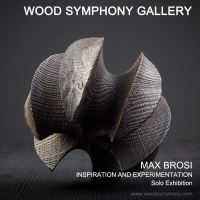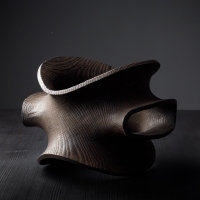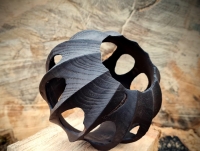Max Brosi
Ireland’s Max Brosi is one of the most inventive and eye-catching woodturners to emerge in recent years. The range of his work is quite remarkable, from fantastic abstract sculptures to deliciously tactile fullbellied vessels. He is a deep thinker about his craft and is renowned both for the ingenuity of his designs and for having the technical prowess to bring them into being.
Max was born in Germany; at the age of two, he moved with his parents to the northwest of Ireland. An only child growing up in the countryside, he remembers carving walking sticks and making bows and arrows with his penknife, and arrowheads from roof slates, “learning how materials work.” At age four, Max was playing with a hammer and saw at his grandfather’s workbench.
After school, he enrolled in Letterfrack Furniture College in Connemara. He loved the place, reveling in the hands-on designing and making. There were three installments in his education there, as he progressed from certificate to degree to a teaching qualification. In the periods between each stage, he did a lot of living, including travels in Central America and training as a diving instructor in County Kerry. He worked for a local furniture maker, producing one-off Max Brosi Roger Bennett furniture pieces, built-in wardrobes, and fitted kitchens. This was good experience and he enjoyed it, but he longed for the opportunity to develop and create work to his own designs.
Woodturning was not on the curriculum in Letterfrack, but Max found a video of Mick O’Donnell turning thin green bowls and was amazed by his work. A photo in a library book of a sculptural piece by Michael Peterson, carved and sandblasted like the layered rocks in California’s Sandstone Canyon, opened his eyes to what could be made from wood. He had a go on an old Graduate lathe in the Letterfrack workshop, grinding gouges to profiles he had seen in the video. His first bowl, he says, was “abysmal,” but undeterred he later bought his first lathe with the initial idea of making three-legged stools to sell in the local market.





